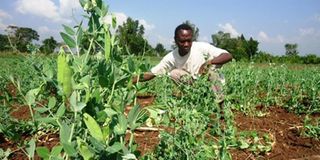Cow pea farmer invests Shs20,000 in seed, now earns Shs3.5m per yield

What you need to know:
With six kilogrammes of seed, this farmer started with a quarter an acre on which he planted cow peas. From this, the yield was more than 40 sacks of cow peas. John Kasule tells Fred Muzaale how he started out, the challenges faced but how profitable the crop is.
I am John Kasule, a resident of Kiziika village, Nazigo sub-county in Kayunga District. I am a vegetable farmer, growing cabbages, tomatoes and cow peas. But in the time, I have grown these vegetables, I have discovered that cowpeas are more profitable than tomatoes and cabbages.
Marketable
This is because peas are fast maturing and I do not have to spend a lot on pesticides and fertilisers to have good harvests.
In 2010, I started growing drought-resistant cowpeas which do well on soil with low fertility. I started with a quarter an acre, where I planted the large green-seeded grain peas. This variety has a green seed coat with a small white eye. I bought six kilogrammes at a cost of Shs 21,000.
I decided on this variety because it is marketable compared to the large white seeded one, like that used in making samosas.
Setting up
I ploughed the land and made the soil fine. It should be fine to make it easy for the small roots to penetrate the soil. I also cut down the trees because cow peas do not thrive well under shade. I planted the seeds at a spacing of 60cm by 20cm with two seeds per hole.
However, it is worth noting that the spacing depends on the type of cow pea because there are those which are erect and those which are semi-erect.
Planting in rows helps to establish the correct plant density. In addition, planting in rows makes weeding and insecticide or fertiliser application easier.
Two weeks after the peas germinated, I started weeding. This is because if you weed when cow peas have started creeping and when they have starting podding, they are likely to be damaged or cut with the hoe.
After they have fruited, it is advisable to uproot the weeds other than remove them with a hoe. To ensure that my crop is not attacked by pests and diseases, I sprayed the plants with pesticides which I bought at Shs 15,000. I sprayed the peas at three weeks.
Since cow peas mature very fast, within two months, they were ready for harvest. I hired people who picked them while the pods were still green.
From the first picking, I got 35 sacks of unthreshed cowpeas. I sold each sack at Shs100,000 to traders from Kampala and Jinja .
Yields
From the 35 sacks, I got Shs3.5m. The traders bought the produce from my garden so I did not incur any transport costs. Though I had sold my peas to traders from Kampala, the market in my area is also available as many people like to eat peas as part of their diet.
Yet again, after only one week, I harvested some more 10 sacks and got Shs700,000. I paid for the labour, I used to plough the land and to harvest the yield.
From the Shs 4.2m earned, I spent about Shs1.3m in labour and farm inputs. At the end of the two months, I had made Shs2.9m.
Challenges
But for a farmer to earn more money from cowpeas, he/she has to time the harvest to when the beans are off-season. This is because cow peas and beans can act as a substitute for each other.
So this means that when the fresh bean is in season, the demand for cow peas is not high.
Growing cow peas has a number of challenges that include pests and diseases, which attack the crop. Cow peas are attacked by bacterial blight and bacterial pustule.
Bacterial blight is seed borne and using high quality seed may reduce incidence of this disease.
The disease also survives on diseased crop residues. Growing cowpea after cowpea, season after season, may therefore increase prevalence of diseases.
The cowpea aphid is another major common pest. The insect feeds on undersurface of young leaves, on young stem tissue and on pods of mature plants. Under severe infestation, there is premature defoliation and death of young seedlings.
Expectations
Leafhoppers is another pests that can destroy cowpea during the seedling stage. Their feeding causes yellow discoloration of leaf veins and margins, followed by cupping of leaves. Plants become stunted.
Both insects can be controlled by spraying the crop with insecticides.
If a farmer does not want to sell fresh peas, the crop should be harvested when they are dry. But a framer should be not wait until when the cow pea ponds shatter, as this leads to crop loss.
After harvesting, they should be sun dried and then threshed. Currently, the area under cow peas is an acre from which I expect to get about Shs5m next season.




